|
|
|
Sort Order |
|
|
|
Items / Page
|
|
|
|
|
|
|
| Srl | Item |
| 1 |
ID:
134024


|
|
|
|
|
| Publication |
2014.
|
| Summary/Abstract |
Collaborative defence projects have been a distinctive feature of European defence industrial policy. This article focuses on whether the number of partner nations in international collaborative defence and aerospace programmes is a source of inefficiency. It appears that there is not a simple linear relationship. Two nation collaborations can be efficient, but conventional wisdom assumes that inefficiencies emerge with more than two partner nations. Inevitably, data problems made what appears to be a simple hypothesis difficult to test. The major result is that there is no evidence that efficiency as measured by development times is adversely affected by the number of partner nations. A limited sample regression and a comparison of Airbus vs. Boeing shows a similar conclusion.
|
|
|
|
|
|
|
|
|
|
|
|
|
|
|
|
| 2 |
ID:
127244


|
|
|
|
|
| Publication |
2014.
|
| Summary/Abstract |
There is an increasing political pressure on the city planning to create more energy efficient city plans. Not only do the city plans have to enable and promote energy efficient solutions, but it also needs to be clearly assessed how energy efficient the plans are. City planners often have no or poor know how about energy efficiency and building technologies which makes it difficult for them to answer to this need without new guidelines and tools. An easy to use tool for the assessment of the energy efficiency of detailed city plans was developed. The aim of the tool is for city planners to easily be able to assess the energy efficiency of the proposed detailed city plan and to be able to compare the impacts of changes in the plan. The tool is designed to be used with no in-depth knowledge about energy or building technology. With a wide use of the tool many missed opportunities for improving energy efficiency can be avoided. It will provide better opportunities for sustainable solutions leading to less harmful environmental impact and reduced emissions.
|
|
|
|
|
|
|
|
|
|
|
|
|
|
|
|
| 3 |
ID:
128000
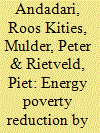

|
|
|
|
|
| Publication |
2014.
|
| Summary/Abstract |
In low- and middle-income countries, Liquefied Petroleum Gas (LPG) can be an attractive alternative to the widespread use of traditional kerosene. Not only is LPG a relatively clean, safe and cost-effective fuel for households, its large-scale adoption also reduces the heavy burden of kerosene consumption subsidies on government budgets. Against this background, we evaluate the impact of a large government program to substitute LPG for kerosene in Indonesia. Using a household survey across urban, suburban and rural regions we find that this program was very effective in causing a large scale shift from kerosene to LPG. This shift was positively influenced by level of education, household size and household income. Contradicting the energy-ladder model, the LPG program, reinforced by an increase in the price of kerosene, led to increased stacking of fuels, including increasing consumption of both electricity and traditional biomass. In addition, our analysis shows that the LPG program failed to substantially reduce the overall number of energy-poor people, but it has been effective in alleviating extreme energy-poverty. Finally, we find that medium and higher income households in suburban areas benefitted most from the LPG program.
|
|
|
|
|
|
|
|
|
|
|
|
|
|
|
|
| 4 |
ID:
127903


|
|
|
|
|
| Publication |
2014.
|
| Summary/Abstract |
This study explores factors related to energy consumers' perceptions of government subsidies for utility provided energy efficiency (EE) programs and for utility providers' use of more clean/alternative energy sources. Demographic factors, attitudes, planned purchases, and perceptions of utility provider motives in relation to governmental and utility provider EE initiatives (i.e. providing discounts and coupons for CFL bulbs), plus the influence of gain- and loss-framed messages are investigated. Over 2000 respondents completed a 16 item phone survey. Hierarchical regression explained 38% of the variance in reactions regarding government subsidies of the cost of utility provided EE programs and 43% of the variance in perceptions involving whether utility companies should use of more clean or alternative forms of energy. Gender and party differences emerged. Loss-framed messages were more important when the issue was government subsidies. Both gain- and loss-framed messages were important when clean/alternative energy was the issue.
|
|
|
|
|
|
|
|
|
|
|
|
|
|
|
|
| 5 |
ID:
127280


|
|
Financial analysis on the proposed renewable heat incentive for: a case study on the solar thermal system
/ Bakar, Siti Hawa Abu; Sukki, Firdaus Muhammad; Iniguez, Roberto Ramirez; Munir, Abu Bakar, Yasin, Siti Hajar Mohd, Mallick, Tapas Kumar, McLennan, Campbell, Rahim, Ruzairi Abdul
|

|
|
|
|
| Publication |
2014.
|
| Summary/Abstract |
This short communication paper focuses on the renewable heat incentive (RHI) scheme in the United Kingdom (UK); and in particular, on its implication on domestic installations of solar thermal systems (STSs). First, a short review on the STS in the UK is provided. Then, a detailed description of the RHI is discussed. A financial analysis is presented afterwards, analysing the impact of the RHI scheme on the applicants, in terms of the net present value and the internal rate of return. From the financial analysis it has been found that the RHI scheme for domestic installations is only attractive if a longer period of RHI payment, i.e. 17 years, or a higher RHI rate i.e. £0.32 per kW h is implemented. The current proposal from the UK government is not financially viable, and as a result, it may hinder the penetration of domestic solar thermal systems in the residential sector in the UK.
|
|
|
|
|
|
|
|
|
|
|
|
|
|
|
|
| 6 |
ID:
127269
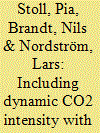

|
|
|
|
|
| Publication |
2014.
|
| Summary/Abstract |
Hourly demand response tariffs with the intention of reducing or shifting loads during peak demand hours are being intensively discussed among policy-makers, researchers and executives of future electricity systems. Demand response rates have still low customer acceptance, apparently because the consumption habits requires stronger incentive to change than any proposed financial incentive. An hourly CO2 intensity signal could give customers an extra environmental motivation to shift or reduce loads during peak hours, as it would enable co-optimisation of electricity consumption costs and carbon emissions reductions. In this study, we calculated the hourly dynamic CO2 signal and applied the calculation to hourly electricity market data in Great Britain, Ontario and Sweden. This provided a novel understanding of the relationships between hourly electricity generation mix composition, electricity price and electricity mix CO2 intensity. Load shifts from high-price hours resulted in carbon emission reductions for electricity generation mixes where price and CO2 intensity were positively correlated. The reduction can be further improved if the shift is optimised using both price and CO2 intensity. The analysis also indicated that an hourly CO2 intensity signal can help avoid carbon emissions increases for mixes with a negative correlation between electricity price and CO2 Intensity.
|
|
|
|
|
|
|
|
|
|
|
|
|
|
|
|
| 7 |
ID:
127241
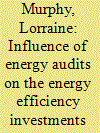

|
|
|
|
|
| Publication |
2014.
|
| Summary/Abstract |
Energy audits are promoted as an effective tool to drive investment in energy efficiency measures in the residential sector. Despite operating in many countries for several decades details of the impact of audits are mixed. The aim of research presented here is to explore the role of audits on investment in energy efficiency measures by private owner-occupied householders in the Netherlands. Results showed that the main influence of the energy audit was to confirm information held by householders. A significant portion of audit recommendations was ignored, the main reason being that householders considered their dwellings to be adequately energy efficient. A comparison of audit recipients to non-recipients showed that audit recipients did not adopt, plan to adopt or invest in more energy efficiency measures than non-recipients. In fact non-recipients adopted more and invested more in measures. It is concluded that energy based renovation is driven by householder perception of comfort and acceptable outlay on energy bills and not necessarily to expert technical tailored information on the potential to reduce CO2 emissions and environmental impact. Results support arguments for minimum energy efficiency standards and performance based incentives.
|
|
|
|
|
|
|
|
|
|
|
|
|
|
|
|
| 8 |
ID:
124521
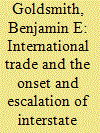

|
|
|
|
|
| Publication |
2013.
|
| Summary/Abstract |
Although study of the relationship between international trade and militarized conflict has become more sophisticated, whether trade reduces the chance of conflict, exacerbates it, or has no effect, remains contested. Integrating expectations from schools of thought often portrayed as incompatible, I consider two aspects of trade - volume and interdependence - and model conflict as a two-stage process involving onset and escalation. This perspective leads to robust statistical findings that trade is Janus-faced, both facilitating and inhibiting conflict at different stages, supporting the conclusion that a focus on international conflict as a communication process promises better theory in international relations.
|
|
|
|
|
|
|
|
|
|
|
|
|
|
|
|
| 9 |
ID:
127249


|
|
|
|
|
| Publication |
2014.
|
| Summary/Abstract |
This study analyses battery electric vehicles (BEVs) in the future German power system and makes projections of the BEVs hourly load profile by car size ('mini', 'small', 'compact' and 'large'). By means of a power plant dispatching optimisation model, the study assesses the optimal BEV charging/discharging strategies in grid-to-vehicle (G2V) and vehicle-to-grid (V2G) schemes. The results show that the 2% rise in power demand required to power these BEVs does not hamper system stability provided an optimal G2V scheme is applied. Moreover, such BEV deployment can contribute to further integrating wind and solar power generation. Applying a V2G scheme would increase the capacity factors of base and mid-load power plants, leading to a higher integration of intermittent renewables and resulting in a decrease in system costs. However, the evaluation of the profitability of BEVs shows that applying a V2G scheme is not a viable economic option due to the high cost of investing in batteries. Some BEV owners would make modest profits (€6 a year), but a higher number would sustain losses, for reasons of scale. For BEVs to become part of the power system, further incentives are necessary to make the business model attractive to car owners
|
|
|
|
|
|
|
|
|
|
|
|
|
|
|
|
| 10 |
ID:
134103


|
|
|
|
|
| Publication |
2012.
|
| Summary/Abstract |
The article presents a critical evaluation of the concepts of human development and weak statehood and outlines the relationship between them. It is argued that weak statehood has a very significant impact on the success of development strategies even if they stem from human development goals. For example, weak statehood has a direct effect on the provision or non-provision of public goods by the state. Therefore, connecting these concepts provides a perspective for analyzing various issues linked to implementation of development strategies. In conclusion, the article presents the concept of 'functional networking' as a tool for development in the anarchic environment of weak statehood. Functional networking is based on placing unmistakable emphasis on the development of individuals (daily livelihood of families), acceptance of Amartya Sen's condition of the freedom of individuals in terms of decision and opportunity, and the involvement of civil society.
|
|
|
|
|
|
|
|
|
|
|
|
|
|
|
|
| 11 |
ID:
128048


|
|
|
|
|
| Publication |
2014.
|
| Summary/Abstract |
Decision makers facing abatement targets need to decide which abatement measures to implement, and in which order. Measure-explicit marginal abatement cost curves depict the cost and abating potential of available mitigation options. Using a simple intertemporal optimization model, we demonstrate why this information is not sufficient to design emission reduction strategies. Because the measures required to achieve ambitious emission reductions cannot be implemented overnight, the optimal strategy to reach a short-term target depends on longer-term targets. For instance, the best strategy to achieve European's ?20% by 2020 target may be to implement some expensive, high-potential, and long-to-implement options required to meet the ?75% by 2050 target. Using just the cheapest abatement options to reach the 2020 target can create a carbon-intensive lock-in and make the 2050 target too expensive to reach. Designing mitigation policies requires information on the speed at which various measures to curb greenhouse gas emissions can be implemented, in addition to the information on the costs and potential of such measures provided by marginal abatement cost curves.
|
|
|
|
|
|
|
|
|
|
|
|
|
|
|
|
| 12 |
ID:
127905
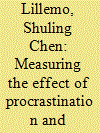

|
|
|
|
|
| Publication |
2014.
|
| Summary/Abstract |
A common finding in behavioural economics is that people often procrastinate, i.e., keep postponing planned tasks or decisions that require effort to execute. The effect of procrastination on inter-temporal energy choice behaviours could be even more serious because energy is an abstract, invisible and intangible commodity. This paper uses a web survey to investigate how people's procrastination propensity and environmental awareness affect their heating-energy-saving behaviours. The results indicate that people who state that they have a higher tendency to procrastinate are significantly less likely to have engaged in most of the heating energy-saving activities, especially regarding larger purchases or investments in equipment and the insulation of doors and windows. I also found a positive relationship between environmental awareness and engaging in everyday energy-saving activities such as reducing the indoor temperature. The findings suggest that measures aimed at reducing procrastination are needed to realise energy-saving potential. It is important to find ways to either bring future benefits closer to the present or to magnify the costs of delayed action. For example, one can employ certain feedback systems and commitment devices to make current gains and future costs more visible or tangible.
|
|
|
|
|
|
|
|
|
|
|
|
|
|
|
|
| 13 |
ID:
130534
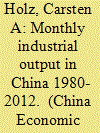

|
|
|
|
|
| Publication |
2014.
|
| Summary/Abstract |
Monthly economic indicators are used for a variety of purposes, from studying business cycles to determining economic policy and making informed business decisions. China's published monthly industrial output statistics could hardly be more confusing, with changes in variables, in coverage, in measurement, and in presentation. This paper reviews the available official data and proceeds to construct a monthly industrial output series in nominal terms and in real terms for the period 1980-2012, economy-wide and for the public sector.
|
|
|
|
|
|
|
|
|
|
|
|
|
|
|
|
| 14 |
ID:
133882


|
|
|
|
|
| Publication |
2014.
|
| Summary/Abstract |
This article provides a statistical decision-making framework for the Gini index through the introduction of practically usable confidence intervals for this index. The resultant intervals enable hypothesis testing with the Gini index as well as providing a mechanism for studying the reliability of its estimates. The article presents these confidence intervals and demonstrates their prospective uses with an illustrative example to officially published estimates for the index from 24 countries
|
|
|
|
|
|
|
|
|
|
|
|
|
|
|
|
| 15 |
ID:
127837


|
|
|
|
|
| Publication |
2013.
|
| Summary/Abstract |
One of the most striking findings in political science is the democratic peace: the absence of war between democracies. Some authors attempt to explain this phenomenon by highlighting the role of public opinion. They observe that democratic leaders are beholden to voters and argue that voters oppose war because of its human and financial costs. This logic predicts that democracies should behave peacefully in general, but history shows that democracies avoid war primarily in their relations with other democracies. In this article we investigate not whether democratic publics are averse to war in general, but whether they are especially reluctant to fight other democracies. We embedded experiments in public opinion polls in the United States and the United Kingdom and found that individuals are substantially less supportive of military strikes against democracies than against otherwise identical autocracies. Moreover, our experiments suggest that shared democracy pacifies the public primarily by changing perceptions of threat and morality, not by raising expectations of costs or failure. These findings shed light on a debate of enduring importance to scholars and policy makers.
|
|
|
|
|
|
|
|
|
|
|
|
|
|
|
|
| 16 |
ID:
131546


|
|
|
|
|
| Publication |
2014.
|
| Summary/Abstract |
The Arab Gulf remains a marginalized, even unfashionable, area of research in the Middle East academy. In spite of-or maybe because of-this marginality, the region offers an interesting vantage point for reflecting on the production of knowledge about geographic and cultural regions. The frame of knowledge production casts into relief discourses of "the city" in Middle East, and particularly Gulf, studies over the past decade.
|
|
|
|
|
|
|
|
|
|
|
|
|
|
|
|
| 17 |
ID:
127229
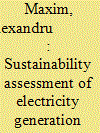

|
|
|
|
|
| Publication |
2014.
|
| Summary/Abstract |
Solving the issue of environmental degradation due to the expansion of the World's energy demand requires a balanced approach. The aim of this paper is to comprehensively rank a large number of electricity generation technologies based on their compatibility with the sustainable development of the industry. The study is based on a set of 10 sustainability indicators which provide a life cycle analysis of the plants. The technologies are ranked using a weighted sum multi-attribute utility method. The indicator weights were established through a survey of 62 academics from the fields of energy and environmental science. Our results show that large hydroelectric projects are the most sustainable technology type, followed by small hydro, onshore wind and solar photovoltaic. We argue that political leaders should have a more structured and strategic approach in implementing sustainable energy policies and this type of research can provide arguments to support such decisions.
|
|
|
|
|
|
|
|
|
|
|
|
|
|
|
|
| 18 |
ID:
125145
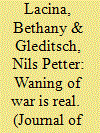

|
|
|
|
|
| Publication |
2013.
|
| Summary/Abstract |
A number of recent studies argue that there is decline in armed conflict within and between nations. Gohdes and Price run against the grain in arguing that there is no evidence for a decrease in battle deaths in armed conflicts after World War II and that the trend reported in our earlier articles is spurious. However, they do not plausibly justify this thesis. We reexamine the argument for a decline, exploring nonlinearities in the data and potential biases due to measurement error. We find that very strong assumptions must hold in order for measurement errors to explain the trend in battle deaths.
|
|
|
|
|
|
|
|
|
|
|
|
|
|
|
|
| 19 |
ID:
130976


|
|
|
|
|
| Publication |
2014.
|
| Summary/Abstract |
In the present study, five stylized facts about China's producer services are established through international, intersectoral and intertemporal comparisons based on input-output tables. First, the overall service input ratio is the lowest in all the sample economies. Second, most producer services are supplied by the traditional labor-intensive sectors. Third, manufacturing is the biggest user of producer services, and service industry is the second, while the opposite is true for most of the other sample economies. Fourth, unlike other economies, China's "R&D" is characterized more by consumer services than producer services. Fifth, China has fairly lower service input ratios in almost all the industries. The backward and forward linkages coefficients are both smaller for "real estate activities" and "finance and insurance." Policy reform should focus not only on specific producer services but also on reducing obstacles that are inhibiting the balanced development of diverse producer services that will help China to optimize its economic structure.
|
|
|
|
|
|
|
|
|
|
|
|
|
|
|
|
|
|
|
|
|